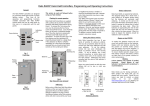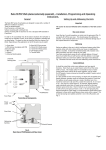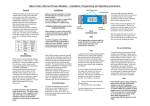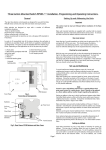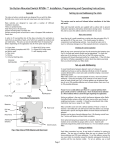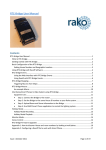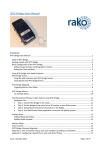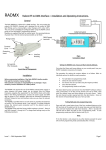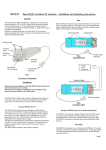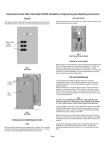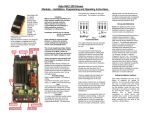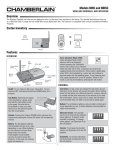Download Rako RCP07 Wall-plates – Installation
Transcript
Rako RCP07 Wall-plates – Installation, Programming and Operating Instructions. Batteries Rear Cover The Rako RCP series of wall-plates are designed to cope with a number of different installation situations. Pull-out These are predominantly: Tab Flush fixing into a UK back-box. Surface mounting with a UK back-box Surface mounting with no back-box or onto a Prise Point European DIN standard or French box. Channel 2 Rako control panels are supplied with a pullout tab to prevent inadvertent operation and battery deterioration during transit. To remove this, first remove the rear cover by inserting the tip of a small screwdriver or similar into the prise point (Fig. 2) and gently lift off the rear cover. This should expose the battery compartment and addressing switches. Care should be taken not to touch or otherwise damage any of the exposed electronic components. Patress PCB Retainer Front Plate Fig 1. Front View of Components With the rear cover removed pull out the tab protecting the batteries (see Fig.2); your Rako control panel should now be operational. To check this press one of the buttons on the front of the PCB retainer and the indicating LED should illuminate briefly for a single flash. If the LED does not flash or it flashes repeatedly for a short burst (low battery warning) then you should contact Rako controls on the number given below. Each Rako transmitter has two, 8 way banks of switches for setting its address. The two sets of switches allow the user to choose from 256 house addresses and 256 room addresses. To set the address, unclip the rear cover whereupon the banks of switches will be now become visible. To set an address, use a small terminal screwdriver or similar device and carefully move some of the switches into the ‘ON’ position. Addressing uses binary encoding and the value of the switches is shown below. Note: Any control panels set with the same address will act as two or multi way controls. 128 64 32 16 8 4 2 1 128 64 32 16 8 4 2 1 ROOM Checking for correct operation Universal backing plate Setting the address switches. ON Important: This Section should be read before the installation of a Rako Control Panel BINARY VALUE Fig 2. Rear View of PCB Retainer and Rear Cover HOUSE Aerial Cutouts 2 x 6mm M3.5 screws. 2 x 25mm M3.5 screws. 2 x 12mm M3.5 screws. 2 x self-tapping screws To avoid interference between rooms or neighbouring installations a Rako system should be set to an address other than the factory default of House 1 Room 4. The preferred addressing method is to select a logical House address number for the project, separate Room addresses for each room within the house and then sequential Channel numbers for each receiver within each room (see Fig.5) i.e. Channel 1 for the 1st receiver, Channel 2 for the 2nd etc. The House and Room addresses are set using the DIP switches on the back of a Rako controller (see Fig.4) and the Channel address is set by ‘stepping’ through the channel numbers with a panel in programming mode (see Step 3 overleaf) and then sending this number (along with the House and Room address) to a receiver (Step 4). ON In order to fit successfully into all the above situations the wall-plate is made from an Addressing assembly of parts, all of which are supplied as Switches standard and are listed below. The parts can also be identified from the drawing Fig1. (Note: Depending on the application not all of the parts may be used) 1 x Front plate. 1 x PCB retainer (complete with PCB and button pad). 1 x Rear cover. 1 x Patress. 1 x Universal backing plate. Set-up and Addressing Before any lighting scenes can be programmed (see the wall panel or handheld instruction manual) the receivers need to be addressed. BINARY VALUE General House address Room address = 128+16=144 = 32+4=36. Fig 4. Addressing Switches House 144 Room 6 Channel 1 Channel 2 House 144 Room 5 Channel 1 144 Fig 5. Addressing Example Notes on addressing. A dimmer will not receive an address of House 0 (All switches set to off) A dimmer will respond to, but not receive an address of Room 0 (All switches set to off). This Room 0 address is used for ‘Master House’ control A dimmer cannot be set to channel 0. To program a lighting scene see Wall panel or Hand held manual. Installation Before assembly ensure that the rear cover is firmly fixed and that the aerial is positioned in a way as to not foul other components. through the PCB retainer and into the bossed inserts. Surface fixing to European back-boxes. Warning Rako wall-plates are designed to operate at safety extra low voltages (6V). When fixing the wallplates to existing back-boxes there may be mains wiring present, if this is the case then the wiring should be made safe, properly insulated and any metal back-boxes earthed. Earthing of the back box is essential if a decorative metal front plate is being used. Should there be any doubt in how to do this contact a qualified electrician. Rako Controls Ltd accepts no responsibility for any damage or injury caused by incorrect installation of a Rako product. For fixing to European DIN or French standard back-boxes the Rako universal backing plate has been designed so that two of the fixing slots match European DIN standard back-box fixings and two match standard French back-box fixings. To mount the assembly, orientate and mount the universal backing plate as applicable (screws not provided) and then follow the instructions for ‘Surface fixing with no backbox’. Care and maintenance Surface fixing to UK back box. Orientate the patress so that the bossed inserts are aligned vertically and locate the PCB retainer in the patress. Then using the 25mm fixing screws fix the front plate to the retainer and patress and backbox. Flush fixing to a UK back-box Fit the PCB retainer in the back-box so that the clear flange is flush to the wall. Then using the 12mm fixing screws (or 25mm if needed) secure the front plate to the PCB retainer and back-box. Note. If a metal front plate is being used, as per the Rako RPP accessories, then the aerial must be positioned outside of the back-box. This is because the front plate and back-box will form a screen for the radio signal, which will give very poor radio transmitting conditions. To position the aerial correctly a hole must be cut in the back-box and a small diameter hole drilled into the wall. Straighten the aerial and push the aerial into the hole. The best radio transmission will be achieved when all of the aerial fully extended and outside of the back-box. If, because of physical constraints, it is not possible to drill the hole in a position close to where the aerial emerges from the PCB retainer, then the rear cover can be removed and the aerial re-positioned in a more convenient aerial cut-out (see fig 2). Surface fixing with no back-box Take the universal backing plate and screw this to the wall (screws not included) using the fixing slots. Rotate the patress so that the bossed inserts are aligned horizontally and then, using the 2 x self-tapping screws, fix the patress to the universal backing plate taking sure not to over-tighten the screws. Insert the PCB retainer into the patress and then using the 2 x 6mm fixing screws, secure the front plate to the patress fixing the screws Battery replacement The Rako RCP series of wall-plates are designed to be powered by batteries. The designed battery life is better than 3 years (based on 30 button presses daily) but the batteries will eventually need replacing. In normal use the Led on the front panel illuminates momentarily when a button is pressed to indicate that a (radio) transmission has been made. When the batteries are approaching the end of their useful life the Led will continue to blink after a button has been pressed. When this starts to happen the batteries should be replaced as soon as possible. Always use two CR2016 To replace the batteries unscrew the front plate and remove the PCB retainer, taking care not to damage the aerial (note that when flush mounted the aerial may be located in a hole outside the back-box). Remove the rear cover and carefully slide out the batteries. Replace with new batteries ensuring that the positive (+) terminal makes contact with the battery clip and the negative (-) terminal with the pad on the circuit board. To ensure reliable operation always ensure that battery contacts and battery surfaces are kept clean of any grease, moisture or other contamination. Warning Lithium batteries may explode if handled incorrectly. Always dispose of used batteries in accordance with manufacturer’s recommendations. General Rako thanks you for having purchased a Rako product and hopes that you are pleased with your system. Should for any reason you need to contact us please contact us via our website www.rakocontrols.com or by phoning our customer help line on 0870-043-3905. Programming Scene Levels The following procedure assumes that all the receivers have already been addressed, see receiver instruction manual for details. Note: If a panel is left in programming mode without pressing a button or a receiver does not receive a command within 3 minutes of the panel going into programming mode they will time out and return to normal mode. Step 1 Put controller into programming mode by pressing and holding the scene button to be programmed a nd both raise and lower buttons together. After 5 seconds the red LED on the panel starts to flash. The panel is now in programming mode. Release the buttons Button 1 2 3 4 Off TIP Press the scene button first TABLE 1 Action Step up one channel and ident Step down one channel and ident Ident No action Exit programming Step 2 Note: A Rako panel will always enter programming mode at C hannel 0. It is not possible to giv e a receiver a n address of Channel 0 but this gives a consistent starting point. Note: When in programming mode the buttons have functions a s detailed in ta ble 1. Note: As soon as the panel enters progra mming mode all receivers controlled by that panel will flash their loads (indicating channel 0). As ea ch individual channel is reached by stepping up a nd down using buttons 1and 2 (see Step 2) that particular channel will flash its load only. If at any point it is desired to check which channel the controller is currently talking to, pressing button 3 will flash that cha nnel’s load without stepping up or down Press button 1 once to step up to the first channel. Adjust the lev el for this cha nnel by using the raise and lower buttons. When the first channel is set at the correct level press button 1again to step up to the second channel and adjust the level using the ra ise and lower buttons. Repeat this until all of the channels are set at the desired level. If at any point it is necessary to go back a channel, pressing button 2 will step down one channel at a time Step 3 When the levels on all the channels are set to the desired levels press button 4 to save the settings Step 4 Press Off button to exit controller from programming mode



